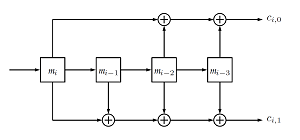Convolutional codes

A shift register encoding circuit, as shown exemplarily in the figure on the right, can be bulit from those generator polynomials. The coefficients of the generator polynomials in reverse order are taken to create the adders of the encoder. A message $\textit{m}$ is coded into a code sequence $\textit{c}$ by bit shifting the message bits through the encoding circuit.
Trellis diagrams of convolutional codes visualize all possible codesequences in a graph. They can be created based on the code sequence output of the shift register (codeword bits of state transitions) and by the different possible memory unit entries of the shift register (possible states). The number of polynomials corresponds to the number of code sequence bits on each state transition. The number of memory units $u$ of the shift register results in $2^u$ states of the trellis. A convolutional code trellis is built from concatenating indentical trellis segments.
